HNN320 Leadership and Clinical Governance: Appendectomy Case Analysis
VerifiedAdded on 2022/09/10
|13
|3741
|20
Case Study
AI Summary
This case study examines the role of a graduate nurse in caring for Nicole, a 23-year-old woman recovering from a laparoscopic appendectomy. The analysis covers potential post-operative complications like wound infections and bowel obstructions, emphasizing the importance of research-based nursing practices for infection control, pain management, and patient education. It highlights the significance of patient participation in decision-making regarding their care, including post-discharge planning and pain management strategies. Furthermore, the study addresses the scope of practice for graduate nurses, emphasizing the need to operate within their competence and adhere to professional standards, and discusses how leadership and management in healthcare, particularly nursing, are critical for ensuring safe and high-quality patient care.
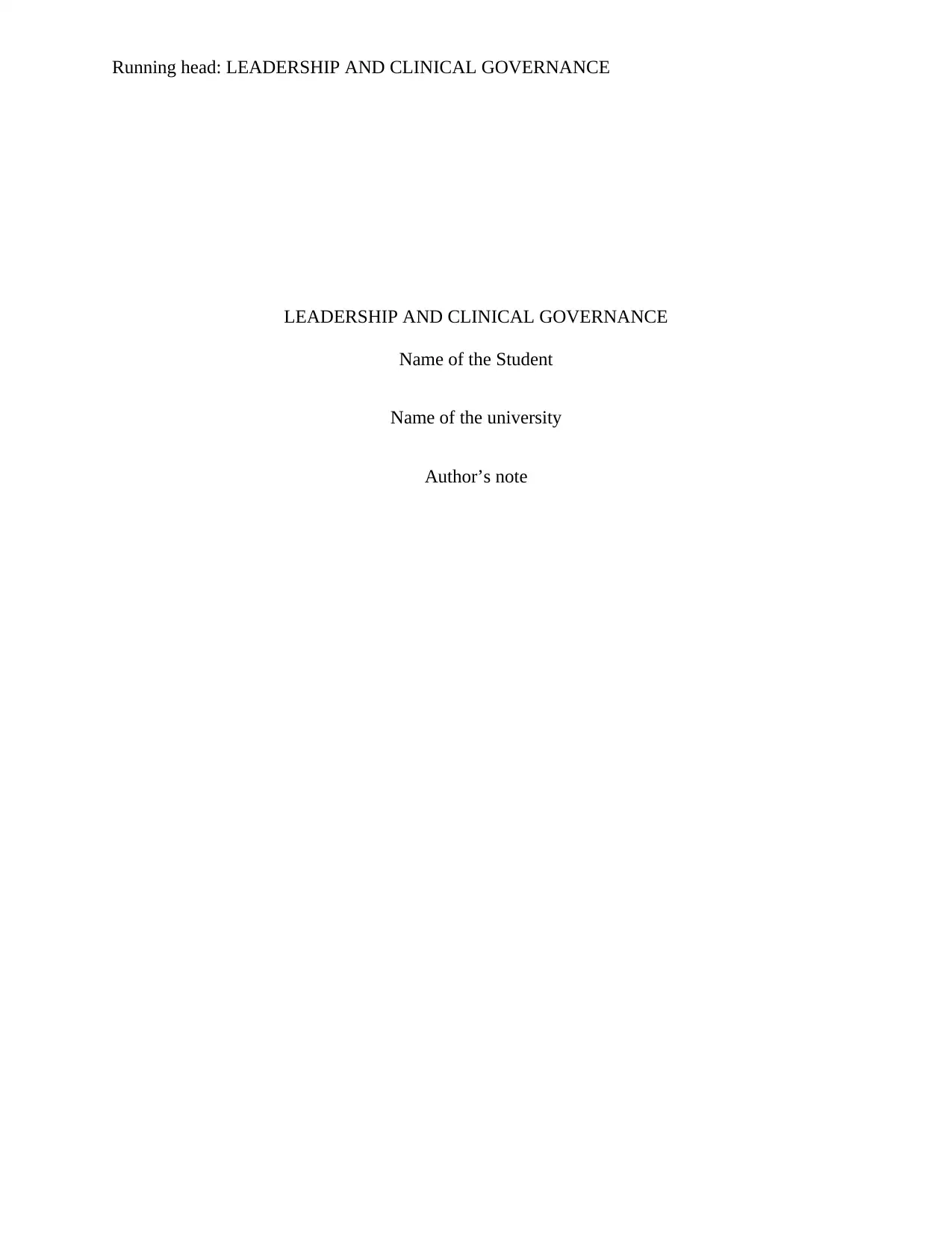
Running head: LEADERSHIP AND CLINICAL GOVERNANCE
LEADERSHIP AND CLINICAL GOVERNANCE
Name of the Student
Name of the university
Author’s note
LEADERSHIP AND CLINICAL GOVERNANCE
Name of the Student
Name of the university
Author’s note
Paraphrase This Document
Need a fresh take? Get an instant paraphrase of this document with our AI Paraphraser
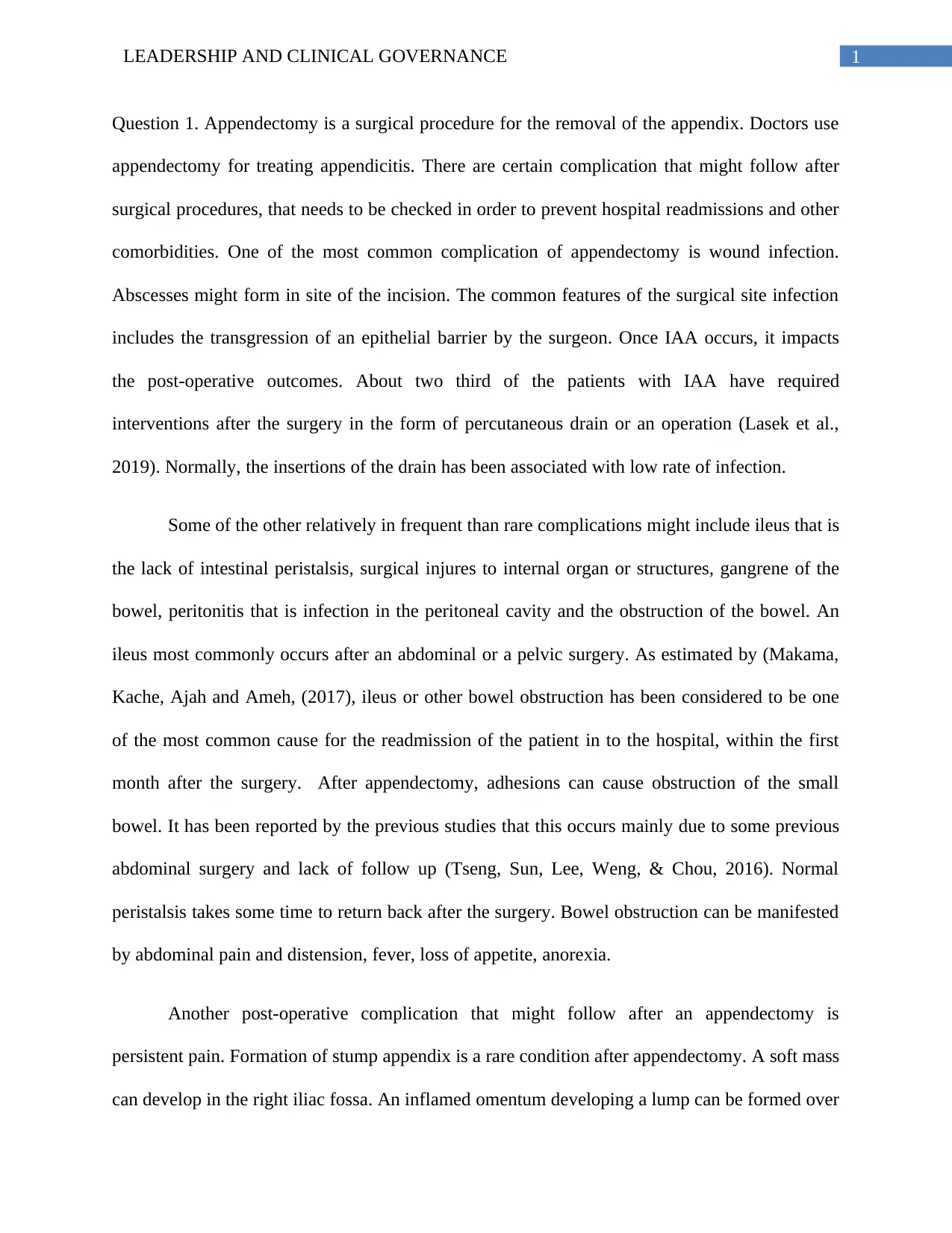
1LEADERSHIP AND CLINICAL GOVERNANCE
Question 1. Appendectomy is a surgical procedure for the removal of the appendix. Doctors use
appendectomy for treating appendicitis. There are certain complication that might follow after
surgical procedures, that needs to be checked in order to prevent hospital readmissions and other
comorbidities. One of the most common complication of appendectomy is wound infection.
Abscesses might form in site of the incision. The common features of the surgical site infection
includes the transgression of an epithelial barrier by the surgeon. Once IAA occurs, it impacts
the post-operative outcomes. About two third of the patients with IAA have required
interventions after the surgery in the form of percutaneous drain or an operation (Lasek et al.,
2019). Normally, the insertions of the drain has been associated with low rate of infection.
Some of the other relatively in frequent than rare complications might include ileus that is
the lack of intestinal peristalsis, surgical injures to internal organ or structures, gangrene of the
bowel, peritonitis that is infection in the peritoneal cavity and the obstruction of the bowel. An
ileus most commonly occurs after an abdominal or a pelvic surgery. As estimated by (Makama,
Kache, Ajah and Ameh, (2017), ileus or other bowel obstruction has been considered to be one
of the most common cause for the readmission of the patient in to the hospital, within the first
month after the surgery. After appendectomy, adhesions can cause obstruction of the small
bowel. It has been reported by the previous studies that this occurs mainly due to some previous
abdominal surgery and lack of follow up (Tseng, Sun, Lee, Weng, & Chou, 2016). Normal
peristalsis takes some time to return back after the surgery. Bowel obstruction can be manifested
by abdominal pain and distension, fever, loss of appetite, anorexia.
Another post-operative complication that might follow after an appendectomy is
persistent pain. Formation of stump appendix is a rare condition after appendectomy. A soft mass
can develop in the right iliac fossa. An inflamed omentum developing a lump can be formed over
Question 1. Appendectomy is a surgical procedure for the removal of the appendix. Doctors use
appendectomy for treating appendicitis. There are certain complication that might follow after
surgical procedures, that needs to be checked in order to prevent hospital readmissions and other
comorbidities. One of the most common complication of appendectomy is wound infection.
Abscesses might form in site of the incision. The common features of the surgical site infection
includes the transgression of an epithelial barrier by the surgeon. Once IAA occurs, it impacts
the post-operative outcomes. About two third of the patients with IAA have required
interventions after the surgery in the form of percutaneous drain or an operation (Lasek et al.,
2019). Normally, the insertions of the drain has been associated with low rate of infection.
Some of the other relatively in frequent than rare complications might include ileus that is
the lack of intestinal peristalsis, surgical injures to internal organ or structures, gangrene of the
bowel, peritonitis that is infection in the peritoneal cavity and the obstruction of the bowel. An
ileus most commonly occurs after an abdominal or a pelvic surgery. As estimated by (Makama,
Kache, Ajah and Ameh, (2017), ileus or other bowel obstruction has been considered to be one
of the most common cause for the readmission of the patient in to the hospital, within the first
month after the surgery. After appendectomy, adhesions can cause obstruction of the small
bowel. It has been reported by the previous studies that this occurs mainly due to some previous
abdominal surgery and lack of follow up (Tseng, Sun, Lee, Weng, & Chou, 2016). Normal
peristalsis takes some time to return back after the surgery. Bowel obstruction can be manifested
by abdominal pain and distension, fever, loss of appetite, anorexia.
Another post-operative complication that might follow after an appendectomy is
persistent pain. Formation of stump appendix is a rare condition after appendectomy. A soft mass
can develop in the right iliac fossa. An inflamed omentum developing a lump can be formed over
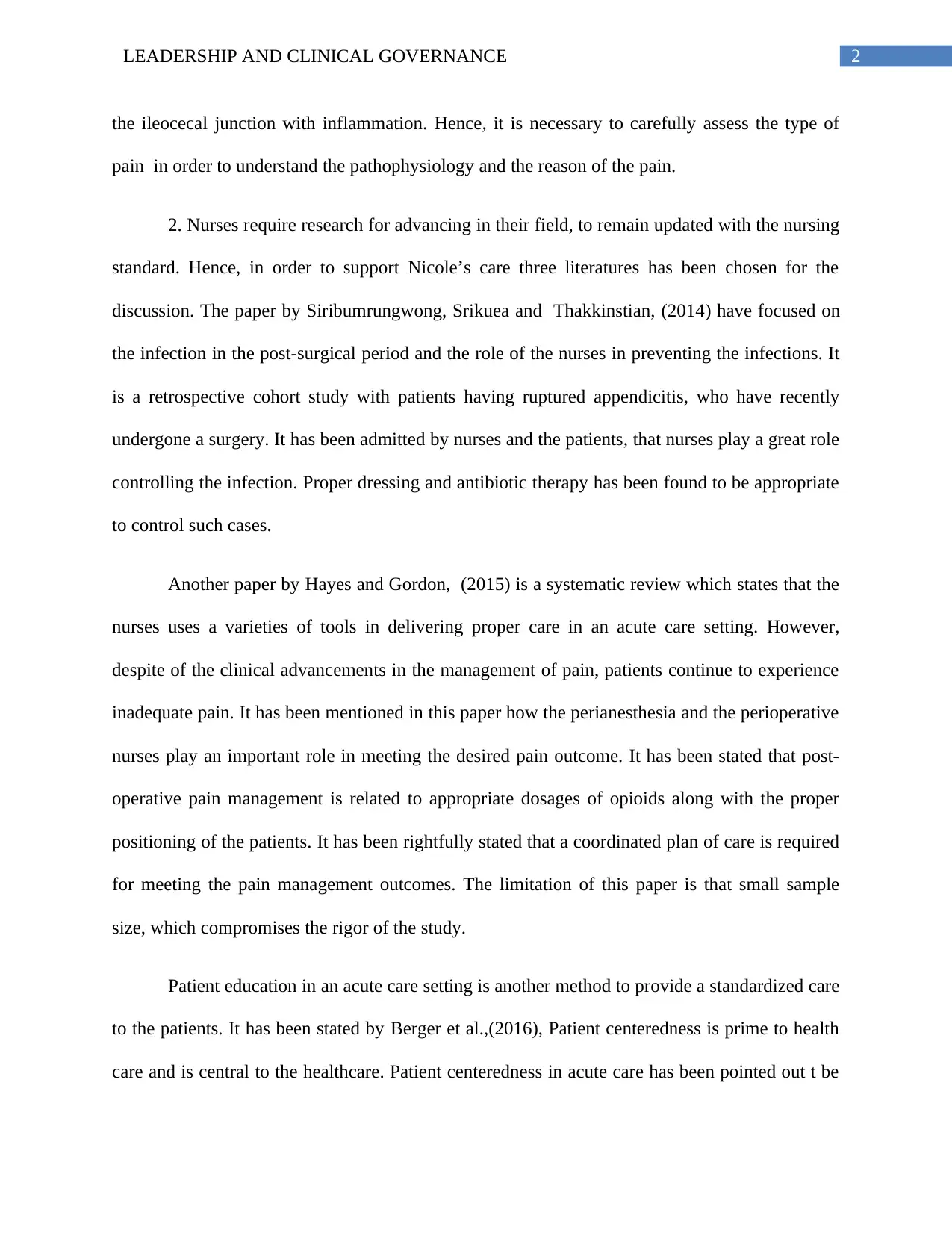
2LEADERSHIP AND CLINICAL GOVERNANCE
the ileocecal junction with inflammation. Hence, it is necessary to carefully assess the type of
pain in order to understand the pathophysiology and the reason of the pain.
2. Nurses require research for advancing in their field, to remain updated with the nursing
standard. Hence, in order to support Nicole’s care three literatures has been chosen for the
discussion. The paper by Siribumrungwong, Srikuea and Thakkinstian, (2014) have focused on
the infection in the post-surgical period and the role of the nurses in preventing the infections. It
is a retrospective cohort study with patients having ruptured appendicitis, who have recently
undergone a surgery. It has been admitted by nurses and the patients, that nurses play a great role
controlling the infection. Proper dressing and antibiotic therapy has been found to be appropriate
to control such cases.
Another paper by Hayes and Gordon, (2015) is a systematic review which states that the
nurses uses a varieties of tools in delivering proper care in an acute care setting. However,
despite of the clinical advancements in the management of pain, patients continue to experience
inadequate pain. It has been mentioned in this paper how the perianesthesia and the perioperative
nurses play an important role in meeting the desired pain outcome. It has been stated that post-
operative pain management is related to appropriate dosages of opioids along with the proper
positioning of the patients. It has been rightfully stated that a coordinated plan of care is required
for meeting the pain management outcomes. The limitation of this paper is that small sample
size, which compromises the rigor of the study.
Patient education in an acute care setting is another method to provide a standardized care
to the patients. It has been stated by Berger et al.,(2016), Patient centeredness is prime to health
care and is central to the healthcare. Patient centeredness in acute care has been pointed out t be
the ileocecal junction with inflammation. Hence, it is necessary to carefully assess the type of
pain in order to understand the pathophysiology and the reason of the pain.
2. Nurses require research for advancing in their field, to remain updated with the nursing
standard. Hence, in order to support Nicole’s care three literatures has been chosen for the
discussion. The paper by Siribumrungwong, Srikuea and Thakkinstian, (2014) have focused on
the infection in the post-surgical period and the role of the nurses in preventing the infections. It
is a retrospective cohort study with patients having ruptured appendicitis, who have recently
undergone a surgery. It has been admitted by nurses and the patients, that nurses play a great role
controlling the infection. Proper dressing and antibiotic therapy has been found to be appropriate
to control such cases.
Another paper by Hayes and Gordon, (2015) is a systematic review which states that the
nurses uses a varieties of tools in delivering proper care in an acute care setting. However,
despite of the clinical advancements in the management of pain, patients continue to experience
inadequate pain. It has been mentioned in this paper how the perianesthesia and the perioperative
nurses play an important role in meeting the desired pain outcome. It has been stated that post-
operative pain management is related to appropriate dosages of opioids along with the proper
positioning of the patients. It has been rightfully stated that a coordinated plan of care is required
for meeting the pain management outcomes. The limitation of this paper is that small sample
size, which compromises the rigor of the study.
Patient education in an acute care setting is another method to provide a standardized care
to the patients. It has been stated by Berger et al.,(2016), Patient centeredness is prime to health
care and is central to the healthcare. Patient centeredness in acute care has been pointed out t be
⊘ This is a preview!⊘
Do you want full access?
Subscribe today to unlock all pages.

Trusted by 1+ million students worldwide
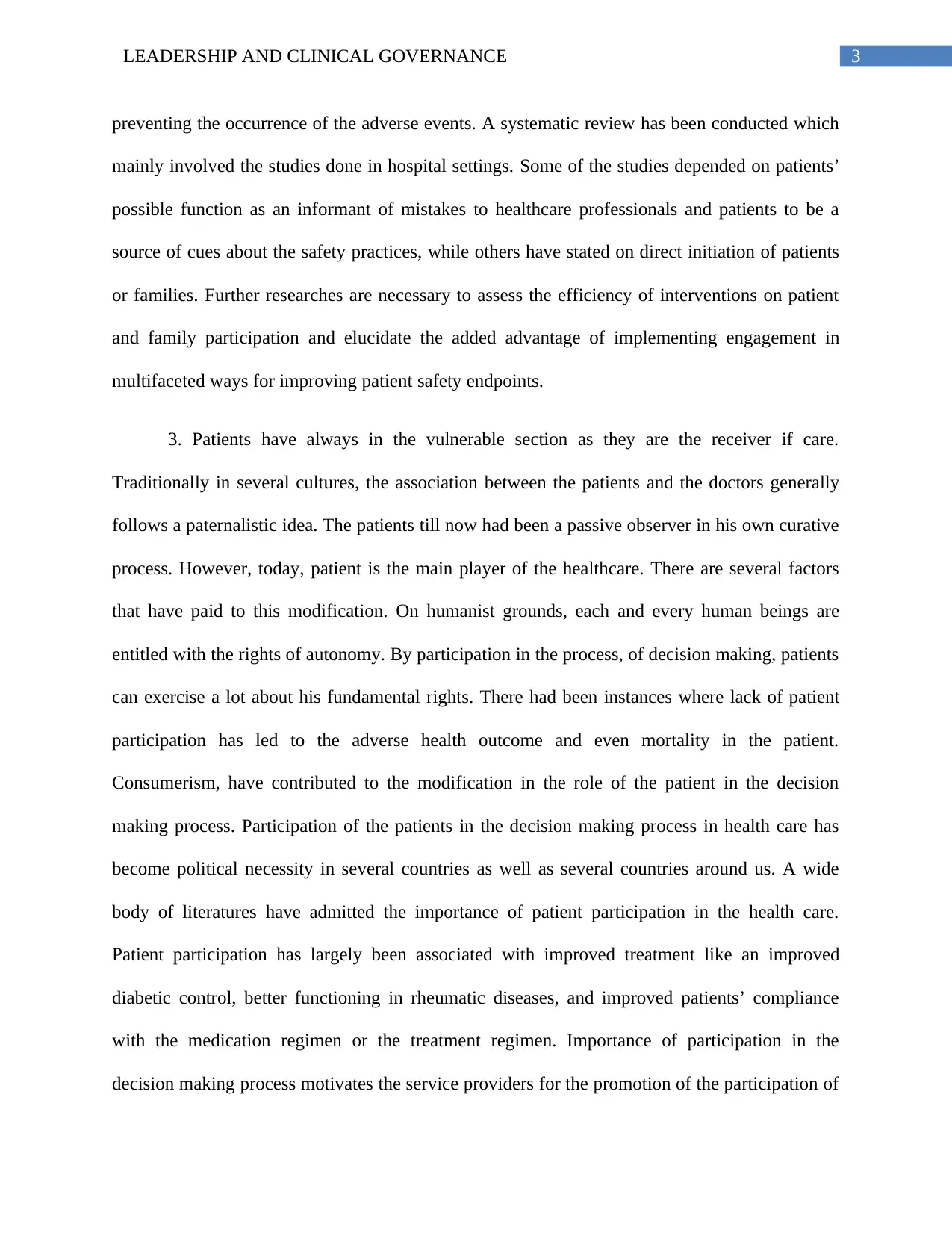
3LEADERSHIP AND CLINICAL GOVERNANCE
preventing the occurrence of the adverse events. A systematic review has been conducted which
mainly involved the studies done in hospital settings. Some of the studies depended on patients’
possible function as an informant of mistakes to healthcare professionals and patients to be a
source of cues about the safety practices, while others have stated on direct initiation of patients
or families. Further researches are necessary to assess the efficiency of interventions on patient
and family participation and elucidate the added advantage of implementing engagement in
multifaceted ways for improving patient safety endpoints.
3. Patients have always in the vulnerable section as they are the receiver if care.
Traditionally in several cultures, the association between the patients and the doctors generally
follows a paternalistic idea. The patients till now had been a passive observer in his own curative
process. However, today, patient is the main player of the healthcare. There are several factors
that have paid to this modification. On humanist grounds, each and every human beings are
entitled with the rights of autonomy. By participation in the process, of decision making, patients
can exercise a lot about his fundamental rights. There had been instances where lack of patient
participation has led to the adverse health outcome and even mortality in the patient.
Consumerism, have contributed to the modification in the role of the patient in the decision
making process. Participation of the patients in the decision making process in health care has
become political necessity in several countries as well as several countries around us. A wide
body of literatures have admitted the importance of patient participation in the health care.
Patient participation has largely been associated with improved treatment like an improved
diabetic control, better functioning in rheumatic diseases, and improved patients’ compliance
with the medication regimen or the treatment regimen. Importance of participation in the
decision making process motivates the service providers for the promotion of the participation of
preventing the occurrence of the adverse events. A systematic review has been conducted which
mainly involved the studies done in hospital settings. Some of the studies depended on patients’
possible function as an informant of mistakes to healthcare professionals and patients to be a
source of cues about the safety practices, while others have stated on direct initiation of patients
or families. Further researches are necessary to assess the efficiency of interventions on patient
and family participation and elucidate the added advantage of implementing engagement in
multifaceted ways for improving patient safety endpoints.
3. Patients have always in the vulnerable section as they are the receiver if care.
Traditionally in several cultures, the association between the patients and the doctors generally
follows a paternalistic idea. The patients till now had been a passive observer in his own curative
process. However, today, patient is the main player of the healthcare. There are several factors
that have paid to this modification. On humanist grounds, each and every human beings are
entitled with the rights of autonomy. By participation in the process, of decision making, patients
can exercise a lot about his fundamental rights. There had been instances where lack of patient
participation has led to the adverse health outcome and even mortality in the patient.
Consumerism, have contributed to the modification in the role of the patient in the decision
making process. Participation of the patients in the decision making process in health care has
become political necessity in several countries as well as several countries around us. A wide
body of literatures have admitted the importance of patient participation in the health care.
Patient participation has largely been associated with improved treatment like an improved
diabetic control, better functioning in rheumatic diseases, and improved patients’ compliance
with the medication regimen or the treatment regimen. Importance of participation in the
decision making process motivates the service providers for the promotion of the participation of
Paraphrase This Document
Need a fresh take? Get an instant paraphrase of this document with our AI Paraphraser

4LEADERSHIP AND CLINICAL GOVERNANCE
the consumers n the decision making process (Vahdat, Hamzehgardeshi, Hessam &
Hamzehgardeshi, 2014). Some of the efforts includes access to multifaceted information
providing the tools and the systems helping the patient in the decision making process. With
enhanced patient involvement and considering the patients to be equal in the decision making
patients are motivated to actively take part in their own treatment regimen and hence a better
maintenance of health will be given (Vahdat, Hamzehgardeshi, Hessam & Hamzehgardeshi,
2014).
It is evident in this Case study, that Nicole is totally unaware of the situation as how long
Nicole would be staying in the hospital or what sort of medical care will be provided to her, or
when will she be discharged or any follow up plan. Being a consumer of heath care Nicole
should also be involved in the decision making process of her own care regimen. She should be
taught about the post discharge follow up plan, or what has to be done after the discharge
including the safety measures of the diets that needs to be maintained.
As discussed in the earlier section, that one of the risk in the post-surgical period is the
presence of persistent pain. Pain is a subjective feeling for making the nurses to understand the
intensity of pain and provide appropriate interventions can really be difficult (McDonall et al.,
2016). Post-operative evaluation and the managing of pain is important in the care for the
recovery unit of the patient, but can be a challenge in spite of the advances made in the post-
operative management of pain. Patients need to express about their pain to the nurses who are in
their charge, or whoever is in the unit. There are several pain assessment scale that should be
used by the patients in order to communicate about their pain intensity (Kaptain, Bregnballe &
Dreyer, 2017). Patients can be included in the process of decision making, for meeting the post-
surgical recovery goals. Additionally, involving patients in the decision making process is also a
the consumers n the decision making process (Vahdat, Hamzehgardeshi, Hessam &
Hamzehgardeshi, 2014). Some of the efforts includes access to multifaceted information
providing the tools and the systems helping the patient in the decision making process. With
enhanced patient involvement and considering the patients to be equal in the decision making
patients are motivated to actively take part in their own treatment regimen and hence a better
maintenance of health will be given (Vahdat, Hamzehgardeshi, Hessam & Hamzehgardeshi,
2014).
It is evident in this Case study, that Nicole is totally unaware of the situation as how long
Nicole would be staying in the hospital or what sort of medical care will be provided to her, or
when will she be discharged or any follow up plan. Being a consumer of heath care Nicole
should also be involved in the decision making process of her own care regimen. She should be
taught about the post discharge follow up plan, or what has to be done after the discharge
including the safety measures of the diets that needs to be maintained.
As discussed in the earlier section, that one of the risk in the post-surgical period is the
presence of persistent pain. Pain is a subjective feeling for making the nurses to understand the
intensity of pain and provide appropriate interventions can really be difficult (McDonall et al.,
2016). Post-operative evaluation and the managing of pain is important in the care for the
recovery unit of the patient, but can be a challenge in spite of the advances made in the post-
operative management of pain. Patients need to express about their pain to the nurses who are in
their charge, or whoever is in the unit. There are several pain assessment scale that should be
used by the patients in order to communicate about their pain intensity (Kaptain, Bregnballe &
Dreyer, 2017). Patients can be included in the process of decision making, for meeting the post-
surgical recovery goals. Additionally, involving patients in the decision making process is also a
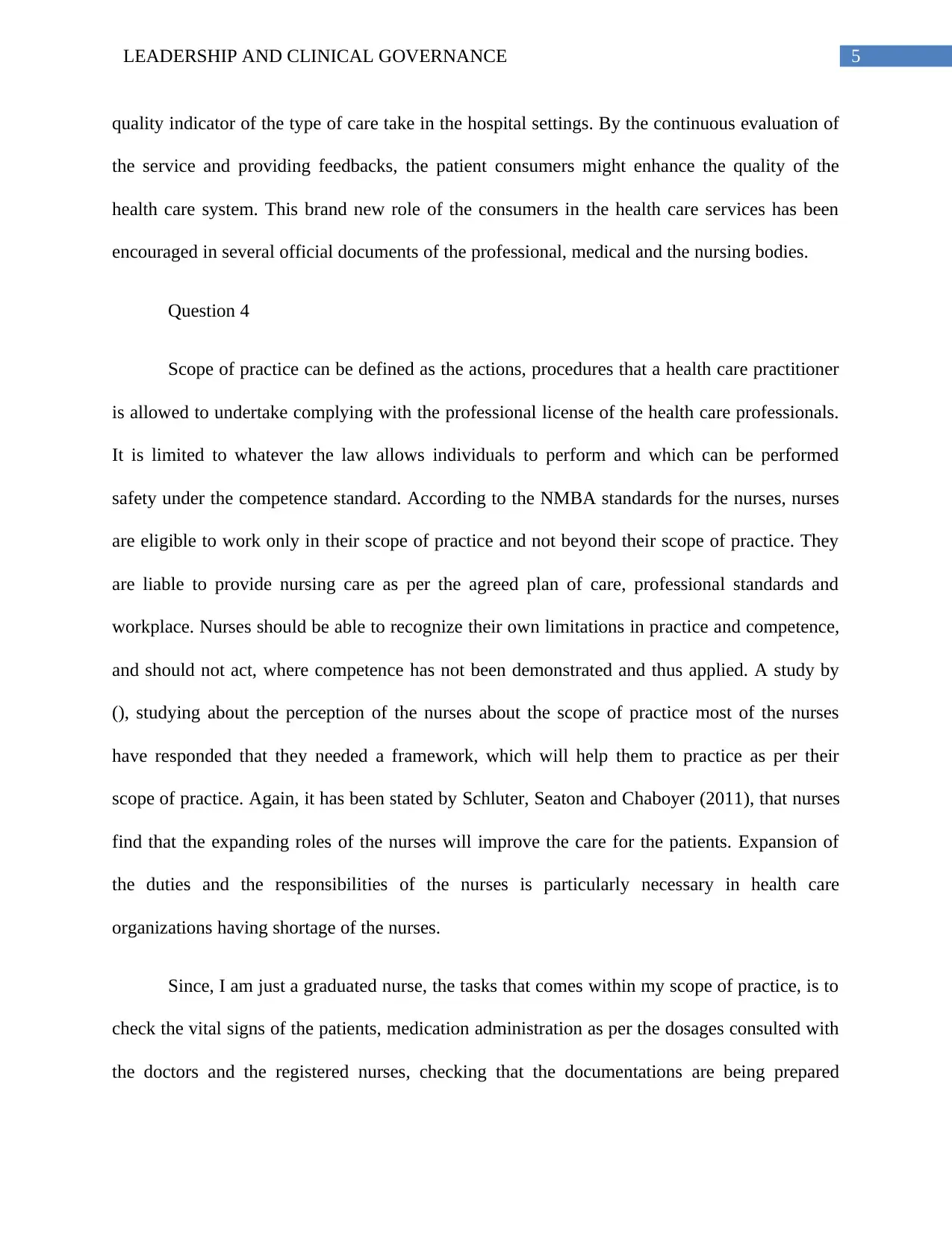
5LEADERSHIP AND CLINICAL GOVERNANCE
quality indicator of the type of care take in the hospital settings. By the continuous evaluation of
the service and providing feedbacks, the patient consumers might enhance the quality of the
health care system. This brand new role of the consumers in the health care services has been
encouraged in several official documents of the professional, medical and the nursing bodies.
Question 4
Scope of practice can be defined as the actions, procedures that a health care practitioner
is allowed to undertake complying with the professional license of the health care professionals.
It is limited to whatever the law allows individuals to perform and which can be performed
safety under the competence standard. According to the NMBA standards for the nurses, nurses
are eligible to work only in their scope of practice and not beyond their scope of practice. They
are liable to provide nursing care as per the agreed plan of care, professional standards and
workplace. Nurses should be able to recognize their own limitations in practice and competence,
and should not act, where competence has not been demonstrated and thus applied. A study by
(), studying about the perception of the nurses about the scope of practice most of the nurses
have responded that they needed a framework, which will help them to practice as per their
scope of practice. Again, it has been stated by Schluter, Seaton and Chaboyer (2011), that nurses
find that the expanding roles of the nurses will improve the care for the patients. Expansion of
the duties and the responsibilities of the nurses is particularly necessary in health care
organizations having shortage of the nurses.
Since, I am just a graduated nurse, the tasks that comes within my scope of practice, is to
check the vital signs of the patients, medication administration as per the dosages consulted with
the doctors and the registered nurses, checking that the documentations are being prepared
quality indicator of the type of care take in the hospital settings. By the continuous evaluation of
the service and providing feedbacks, the patient consumers might enhance the quality of the
health care system. This brand new role of the consumers in the health care services has been
encouraged in several official documents of the professional, medical and the nursing bodies.
Question 4
Scope of practice can be defined as the actions, procedures that a health care practitioner
is allowed to undertake complying with the professional license of the health care professionals.
It is limited to whatever the law allows individuals to perform and which can be performed
safety under the competence standard. According to the NMBA standards for the nurses, nurses
are eligible to work only in their scope of practice and not beyond their scope of practice. They
are liable to provide nursing care as per the agreed plan of care, professional standards and
workplace. Nurses should be able to recognize their own limitations in practice and competence,
and should not act, where competence has not been demonstrated and thus applied. A study by
(), studying about the perception of the nurses about the scope of practice most of the nurses
have responded that they needed a framework, which will help them to practice as per their
scope of practice. Again, it has been stated by Schluter, Seaton and Chaboyer (2011), that nurses
find that the expanding roles of the nurses will improve the care for the patients. Expansion of
the duties and the responsibilities of the nurses is particularly necessary in health care
organizations having shortage of the nurses.
Since, I am just a graduated nurse, the tasks that comes within my scope of practice, is to
check the vital signs of the patients, medication administration as per the dosages consulted with
the doctors and the registered nurses, checking that the documentations are being prepared
⊘ This is a preview!⊘
Do you want full access?
Subscribe today to unlock all pages.

Trusted by 1+ million students worldwide
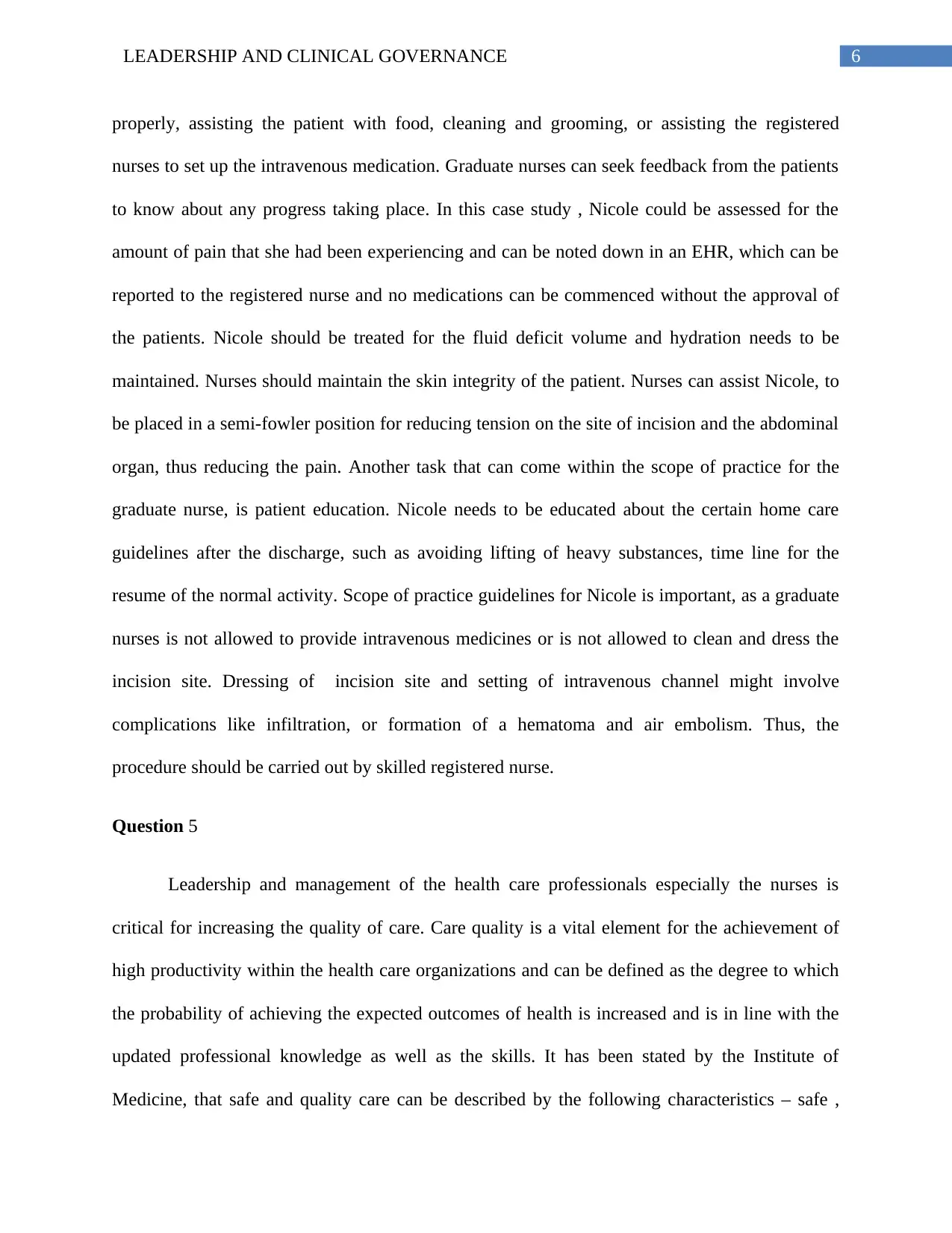
6LEADERSHIP AND CLINICAL GOVERNANCE
properly, assisting the patient with food, cleaning and grooming, or assisting the registered
nurses to set up the intravenous medication. Graduate nurses can seek feedback from the patients
to know about any progress taking place. In this case study , Nicole could be assessed for the
amount of pain that she had been experiencing and can be noted down in an EHR, which can be
reported to the registered nurse and no medications can be commenced without the approval of
the patients. Nicole should be treated for the fluid deficit volume and hydration needs to be
maintained. Nurses should maintain the skin integrity of the patient. Nurses can assist Nicole, to
be placed in a semi-fowler position for reducing tension on the site of incision and the abdominal
organ, thus reducing the pain. Another task that can come within the scope of practice for the
graduate nurse, is patient education. Nicole needs to be educated about the certain home care
guidelines after the discharge, such as avoiding lifting of heavy substances, time line for the
resume of the normal activity. Scope of practice guidelines for Nicole is important, as a graduate
nurses is not allowed to provide intravenous medicines or is not allowed to clean and dress the
incision site. Dressing of incision site and setting of intravenous channel might involve
complications like infiltration, or formation of a hematoma and air embolism. Thus, the
procedure should be carried out by skilled registered nurse.
Question 5
Leadership and management of the health care professionals especially the nurses is
critical for increasing the quality of care. Care quality is a vital element for the achievement of
high productivity within the health care organizations and can be defined as the degree to which
the probability of achieving the expected outcomes of health is increased and is in line with the
updated professional knowledge as well as the skills. It has been stated by the Institute of
Medicine, that safe and quality care can be described by the following characteristics – safe ,
properly, assisting the patient with food, cleaning and grooming, or assisting the registered
nurses to set up the intravenous medication. Graduate nurses can seek feedback from the patients
to know about any progress taking place. In this case study , Nicole could be assessed for the
amount of pain that she had been experiencing and can be noted down in an EHR, which can be
reported to the registered nurse and no medications can be commenced without the approval of
the patients. Nicole should be treated for the fluid deficit volume and hydration needs to be
maintained. Nurses should maintain the skin integrity of the patient. Nurses can assist Nicole, to
be placed in a semi-fowler position for reducing tension on the site of incision and the abdominal
organ, thus reducing the pain. Another task that can come within the scope of practice for the
graduate nurse, is patient education. Nicole needs to be educated about the certain home care
guidelines after the discharge, such as avoiding lifting of heavy substances, time line for the
resume of the normal activity. Scope of practice guidelines for Nicole is important, as a graduate
nurses is not allowed to provide intravenous medicines or is not allowed to clean and dress the
incision site. Dressing of incision site and setting of intravenous channel might involve
complications like infiltration, or formation of a hematoma and air embolism. Thus, the
procedure should be carried out by skilled registered nurse.
Question 5
Leadership and management of the health care professionals especially the nurses is
critical for increasing the quality of care. Care quality is a vital element for the achievement of
high productivity within the health care organizations and can be defined as the degree to which
the probability of achieving the expected outcomes of health is increased and is in line with the
updated professional knowledge as well as the skills. It has been stated by the Institute of
Medicine, that safe and quality care can be described by the following characteristics – safe ,
Paraphrase This Document
Need a fresh take? Get an instant paraphrase of this document with our AI Paraphraser
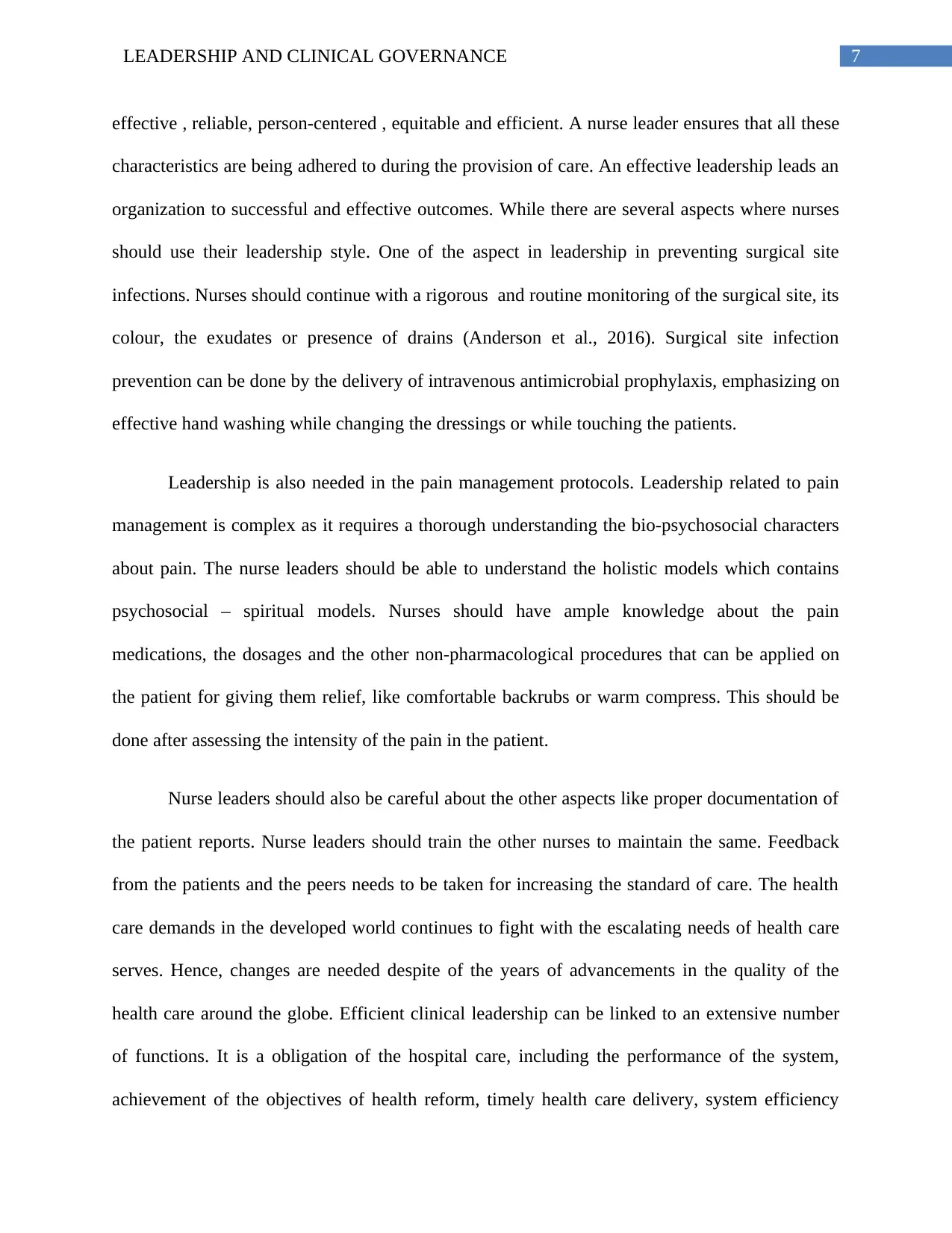
7LEADERSHIP AND CLINICAL GOVERNANCE
effective , reliable, person-centered , equitable and efficient. A nurse leader ensures that all these
characteristics are being adhered to during the provision of care. An effective leadership leads an
organization to successful and effective outcomes. While there are several aspects where nurses
should use their leadership style. One of the aspect in leadership in preventing surgical site
infections. Nurses should continue with a rigorous and routine monitoring of the surgical site, its
colour, the exudates or presence of drains (Anderson et al., 2016). Surgical site infection
prevention can be done by the delivery of intravenous antimicrobial prophylaxis, emphasizing on
effective hand washing while changing the dressings or while touching the patients.
Leadership is also needed in the pain management protocols. Leadership related to pain
management is complex as it requires a thorough understanding the bio-psychosocial characters
about pain. The nurse leaders should be able to understand the holistic models which contains
psychosocial – spiritual models. Nurses should have ample knowledge about the pain
medications, the dosages and the other non-pharmacological procedures that can be applied on
the patient for giving them relief, like comfortable backrubs or warm compress. This should be
done after assessing the intensity of the pain in the patient.
Nurse leaders should also be careful about the other aspects like proper documentation of
the patient reports. Nurse leaders should train the other nurses to maintain the same. Feedback
from the patients and the peers needs to be taken for increasing the standard of care. The health
care demands in the developed world continues to fight with the escalating needs of health care
serves. Hence, changes are needed despite of the years of advancements in the quality of the
health care around the globe. Efficient clinical leadership can be linked to an extensive number
of functions. It is a obligation of the hospital care, including the performance of the system,
achievement of the objectives of health reform, timely health care delivery, system efficiency
effective , reliable, person-centered , equitable and efficient. A nurse leader ensures that all these
characteristics are being adhered to during the provision of care. An effective leadership leads an
organization to successful and effective outcomes. While there are several aspects where nurses
should use their leadership style. One of the aspect in leadership in preventing surgical site
infections. Nurses should continue with a rigorous and routine monitoring of the surgical site, its
colour, the exudates or presence of drains (Anderson et al., 2016). Surgical site infection
prevention can be done by the delivery of intravenous antimicrobial prophylaxis, emphasizing on
effective hand washing while changing the dressings or while touching the patients.
Leadership is also needed in the pain management protocols. Leadership related to pain
management is complex as it requires a thorough understanding the bio-psychosocial characters
about pain. The nurse leaders should be able to understand the holistic models which contains
psychosocial – spiritual models. Nurses should have ample knowledge about the pain
medications, the dosages and the other non-pharmacological procedures that can be applied on
the patient for giving them relief, like comfortable backrubs or warm compress. This should be
done after assessing the intensity of the pain in the patient.
Nurse leaders should also be careful about the other aspects like proper documentation of
the patient reports. Nurse leaders should train the other nurses to maintain the same. Feedback
from the patients and the peers needs to be taken for increasing the standard of care. The health
care demands in the developed world continues to fight with the escalating needs of health care
serves. Hence, changes are needed despite of the years of advancements in the quality of the
health care around the globe. Efficient clinical leadership can be linked to an extensive number
of functions. It is a obligation of the hospital care, including the performance of the system,
achievement of the objectives of health reform, timely health care delivery, system efficiency
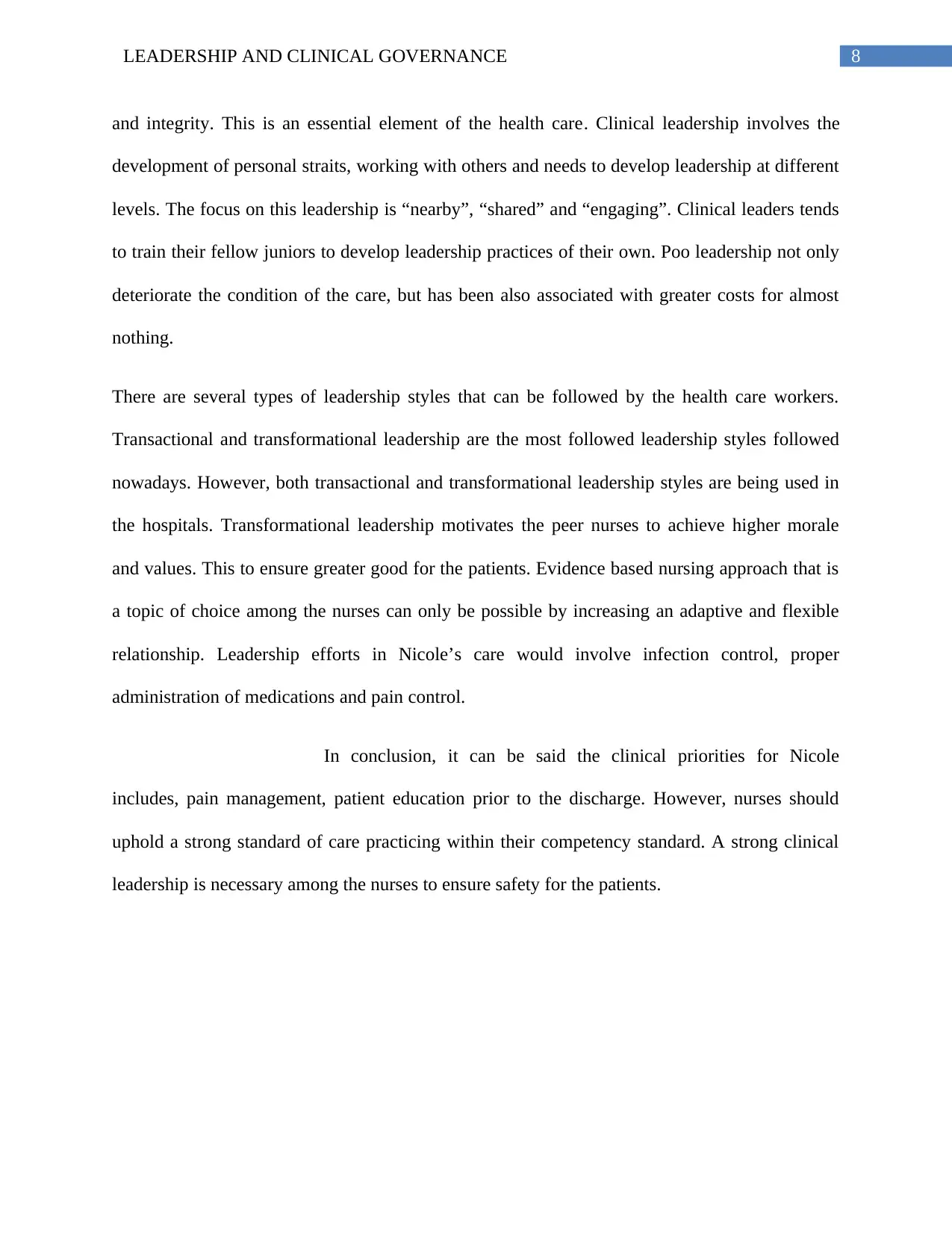
8LEADERSHIP AND CLINICAL GOVERNANCE
and integrity. This is an essential element of the health care. Clinical leadership involves the
development of personal straits, working with others and needs to develop leadership at different
levels. The focus on this leadership is “nearby”, “shared” and “engaging”. Clinical leaders tends
to train their fellow juniors to develop leadership practices of their own. Poo leadership not only
deteriorate the condition of the care, but has been also associated with greater costs for almost
nothing.
There are several types of leadership styles that can be followed by the health care workers.
Transactional and transformational leadership are the most followed leadership styles followed
nowadays. However, both transactional and transformational leadership styles are being used in
the hospitals. Transformational leadership motivates the peer nurses to achieve higher morale
and values. This to ensure greater good for the patients. Evidence based nursing approach that is
a topic of choice among the nurses can only be possible by increasing an adaptive and flexible
relationship. Leadership efforts in Nicole’s care would involve infection control, proper
administration of medications and pain control.
In conclusion, it can be said the clinical priorities for Nicole
includes, pain management, patient education prior to the discharge. However, nurses should
uphold a strong standard of care practicing within their competency standard. A strong clinical
leadership is necessary among the nurses to ensure safety for the patients.
and integrity. This is an essential element of the health care. Clinical leadership involves the
development of personal straits, working with others and needs to develop leadership at different
levels. The focus on this leadership is “nearby”, “shared” and “engaging”. Clinical leaders tends
to train their fellow juniors to develop leadership practices of their own. Poo leadership not only
deteriorate the condition of the care, but has been also associated with greater costs for almost
nothing.
There are several types of leadership styles that can be followed by the health care workers.
Transactional and transformational leadership are the most followed leadership styles followed
nowadays. However, both transactional and transformational leadership styles are being used in
the hospitals. Transformational leadership motivates the peer nurses to achieve higher morale
and values. This to ensure greater good for the patients. Evidence based nursing approach that is
a topic of choice among the nurses can only be possible by increasing an adaptive and flexible
relationship. Leadership efforts in Nicole’s care would involve infection control, proper
administration of medications and pain control.
In conclusion, it can be said the clinical priorities for Nicole
includes, pain management, patient education prior to the discharge. However, nurses should
uphold a strong standard of care practicing within their competency standard. A strong clinical
leadership is necessary among the nurses to ensure safety for the patients.
⊘ This is a preview!⊘
Do you want full access?
Subscribe today to unlock all pages.

Trusted by 1+ million students worldwide
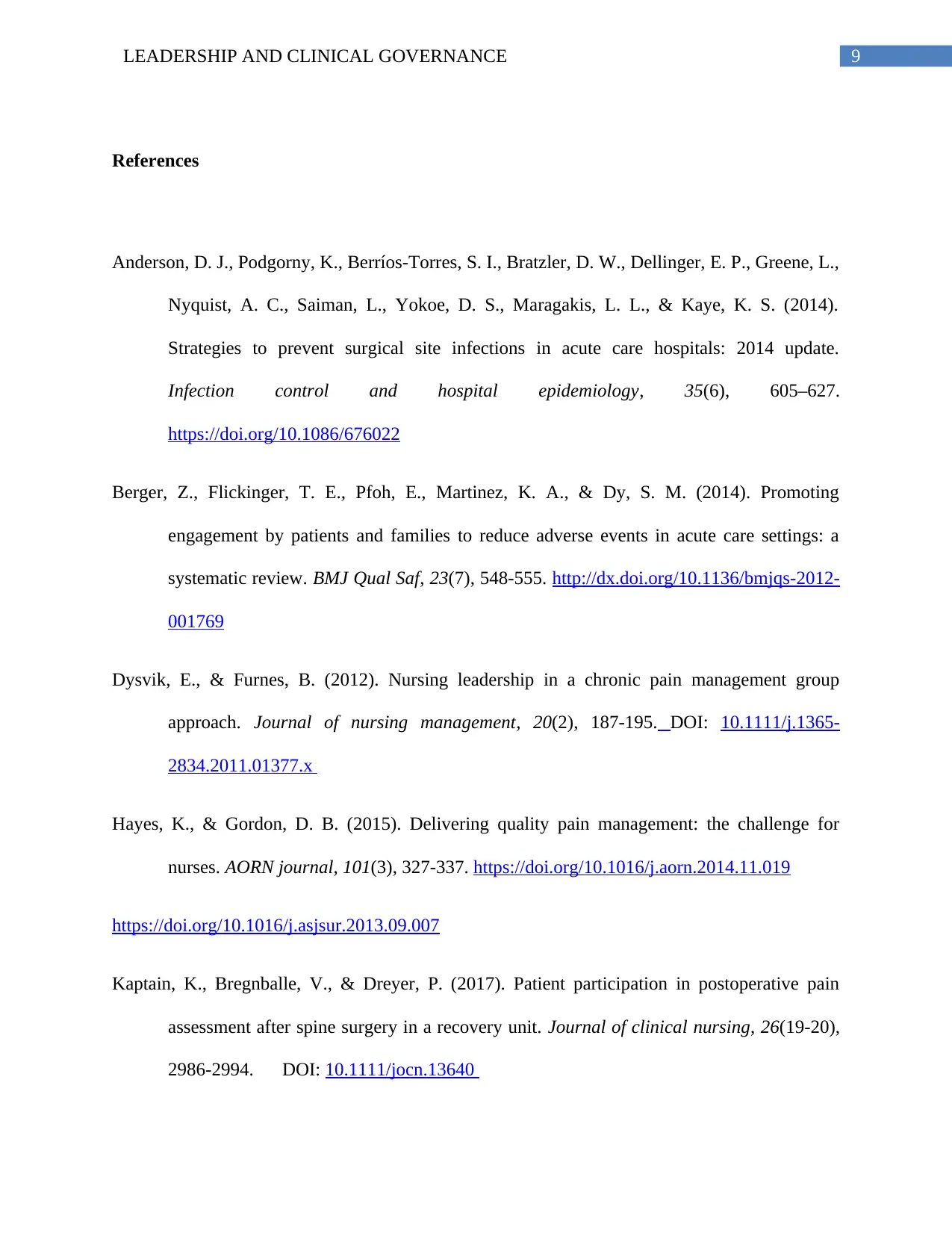
9LEADERSHIP AND CLINICAL GOVERNANCE
References
Anderson, D. J., Podgorny, K., Berríos-Torres, S. I., Bratzler, D. W., Dellinger, E. P., Greene, L.,
Nyquist, A. C., Saiman, L., Yokoe, D. S., Maragakis, L. L., & Kaye, K. S. (2014).
Strategies to prevent surgical site infections in acute care hospitals: 2014 update.
Infection control and hospital epidemiology, 35(6), 605–627.
https://doi.org/10.1086/676022
Berger, Z., Flickinger, T. E., Pfoh, E., Martinez, K. A., & Dy, S. M. (2014). Promoting
engagement by patients and families to reduce adverse events in acute care settings: a
systematic review. BMJ Qual Saf, 23(7), 548-555. http://dx.doi.org/10.1136/bmjqs-2012-
001769
Dysvik, E., & Furnes, B. (2012). Nursing leadership in a chronic pain management group
approach. Journal of nursing management, 20(2), 187-195. DOI: 10.1111/j.1365-
2834.2011.01377.x
Hayes, K., & Gordon, D. B. (2015). Delivering quality pain management: the challenge for
nurses. AORN journal, 101(3), 327-337. https://doi.org/10.1016/j.aorn.2014.11.019
https://doi.org/10.1016/j.asjsur.2013.09.007
Kaptain, K., Bregnballe, V., & Dreyer, P. (2017). Patient participation in postoperative pain
assessment after spine surgery in a recovery unit. Journal of clinical nursing, 26(19-20),
2986-2994. DOI: 10.1111/jocn.13640
References
Anderson, D. J., Podgorny, K., Berríos-Torres, S. I., Bratzler, D. W., Dellinger, E. P., Greene, L.,
Nyquist, A. C., Saiman, L., Yokoe, D. S., Maragakis, L. L., & Kaye, K. S. (2014).
Strategies to prevent surgical site infections in acute care hospitals: 2014 update.
Infection control and hospital epidemiology, 35(6), 605–627.
https://doi.org/10.1086/676022
Berger, Z., Flickinger, T. E., Pfoh, E., Martinez, K. A., & Dy, S. M. (2014). Promoting
engagement by patients and families to reduce adverse events in acute care settings: a
systematic review. BMJ Qual Saf, 23(7), 548-555. http://dx.doi.org/10.1136/bmjqs-2012-
001769
Dysvik, E., & Furnes, B. (2012). Nursing leadership in a chronic pain management group
approach. Journal of nursing management, 20(2), 187-195. DOI: 10.1111/j.1365-
2834.2011.01377.x
Hayes, K., & Gordon, D. B. (2015). Delivering quality pain management: the challenge for
nurses. AORN journal, 101(3), 327-337. https://doi.org/10.1016/j.aorn.2014.11.019
https://doi.org/10.1016/j.asjsur.2013.09.007
Kaptain, K., Bregnballe, V., & Dreyer, P. (2017). Patient participation in postoperative pain
assessment after spine surgery in a recovery unit. Journal of clinical nursing, 26(19-20),
2986-2994. DOI: 10.1111/jocn.13640
Paraphrase This Document
Need a fresh take? Get an instant paraphrase of this document with our AI Paraphraser
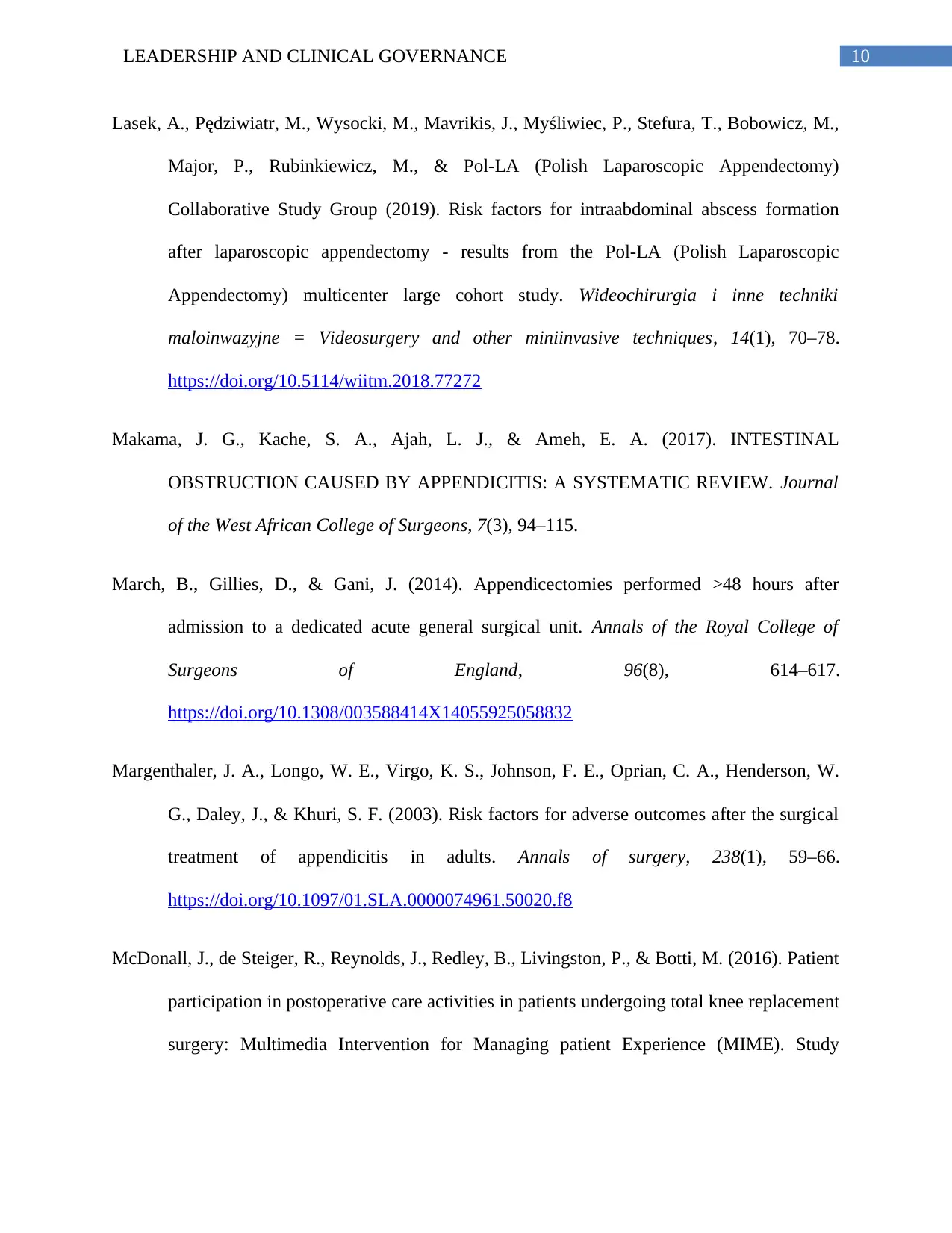
10LEADERSHIP AND CLINICAL GOVERNANCE
Lasek, A., Pędziwiatr, M., Wysocki, M., Mavrikis, J., Myśliwiec, P., Stefura, T., Bobowicz, M.,
Major, P., Rubinkiewicz, M., & Pol-LA (Polish Laparoscopic Appendectomy)
Collaborative Study Group (2019). Risk factors for intraabdominal abscess formation
after laparoscopic appendectomy - results from the Pol-LA (Polish Laparoscopic
Appendectomy) multicenter large cohort study. Wideochirurgia i inne techniki
maloinwazyjne = Videosurgery and other miniinvasive techniques, 14(1), 70–78.
https://doi.org/10.5114/wiitm.2018.77272
Makama, J. G., Kache, S. A., Ajah, L. J., & Ameh, E. A. (2017). INTESTINAL
OBSTRUCTION CAUSED BY APPENDICITIS: A SYSTEMATIC REVIEW. Journal
of the West African College of Surgeons, 7(3), 94–115.
March, B., Gillies, D., & Gani, J. (2014). Appendicectomies performed >48 hours after
admission to a dedicated acute general surgical unit. Annals of the Royal College of
Surgeons of England, 96(8), 614–617.
https://doi.org/10.1308/003588414X14055925058832
Margenthaler, J. A., Longo, W. E., Virgo, K. S., Johnson, F. E., Oprian, C. A., Henderson, W.
G., Daley, J., & Khuri, S. F. (2003). Risk factors for adverse outcomes after the surgical
treatment of appendicitis in adults. Annals of surgery, 238(1), 59–66.
https://doi.org/10.1097/01.SLA.0000074961.50020.f8
McDonall, J., de Steiger, R., Reynolds, J., Redley, B., Livingston, P., & Botti, M. (2016). Patient
participation in postoperative care activities in patients undergoing total knee replacement
surgery: Multimedia Intervention for Managing patient Experience (MIME). Study
Lasek, A., Pędziwiatr, M., Wysocki, M., Mavrikis, J., Myśliwiec, P., Stefura, T., Bobowicz, M.,
Major, P., Rubinkiewicz, M., & Pol-LA (Polish Laparoscopic Appendectomy)
Collaborative Study Group (2019). Risk factors for intraabdominal abscess formation
after laparoscopic appendectomy - results from the Pol-LA (Polish Laparoscopic
Appendectomy) multicenter large cohort study. Wideochirurgia i inne techniki
maloinwazyjne = Videosurgery and other miniinvasive techniques, 14(1), 70–78.
https://doi.org/10.5114/wiitm.2018.77272
Makama, J. G., Kache, S. A., Ajah, L. J., & Ameh, E. A. (2017). INTESTINAL
OBSTRUCTION CAUSED BY APPENDICITIS: A SYSTEMATIC REVIEW. Journal
of the West African College of Surgeons, 7(3), 94–115.
March, B., Gillies, D., & Gani, J. (2014). Appendicectomies performed >48 hours after
admission to a dedicated acute general surgical unit. Annals of the Royal College of
Surgeons of England, 96(8), 614–617.
https://doi.org/10.1308/003588414X14055925058832
Margenthaler, J. A., Longo, W. E., Virgo, K. S., Johnson, F. E., Oprian, C. A., Henderson, W.
G., Daley, J., & Khuri, S. F. (2003). Risk factors for adverse outcomes after the surgical
treatment of appendicitis in adults. Annals of surgery, 238(1), 59–66.
https://doi.org/10.1097/01.SLA.0000074961.50020.f8
McDonall, J., de Steiger, R., Reynolds, J., Redley, B., Livingston, P., & Botti, M. (2016). Patient
participation in postoperative care activities in patients undergoing total knee replacement
surgery: Multimedia Intervention for Managing patient Experience (MIME). Study
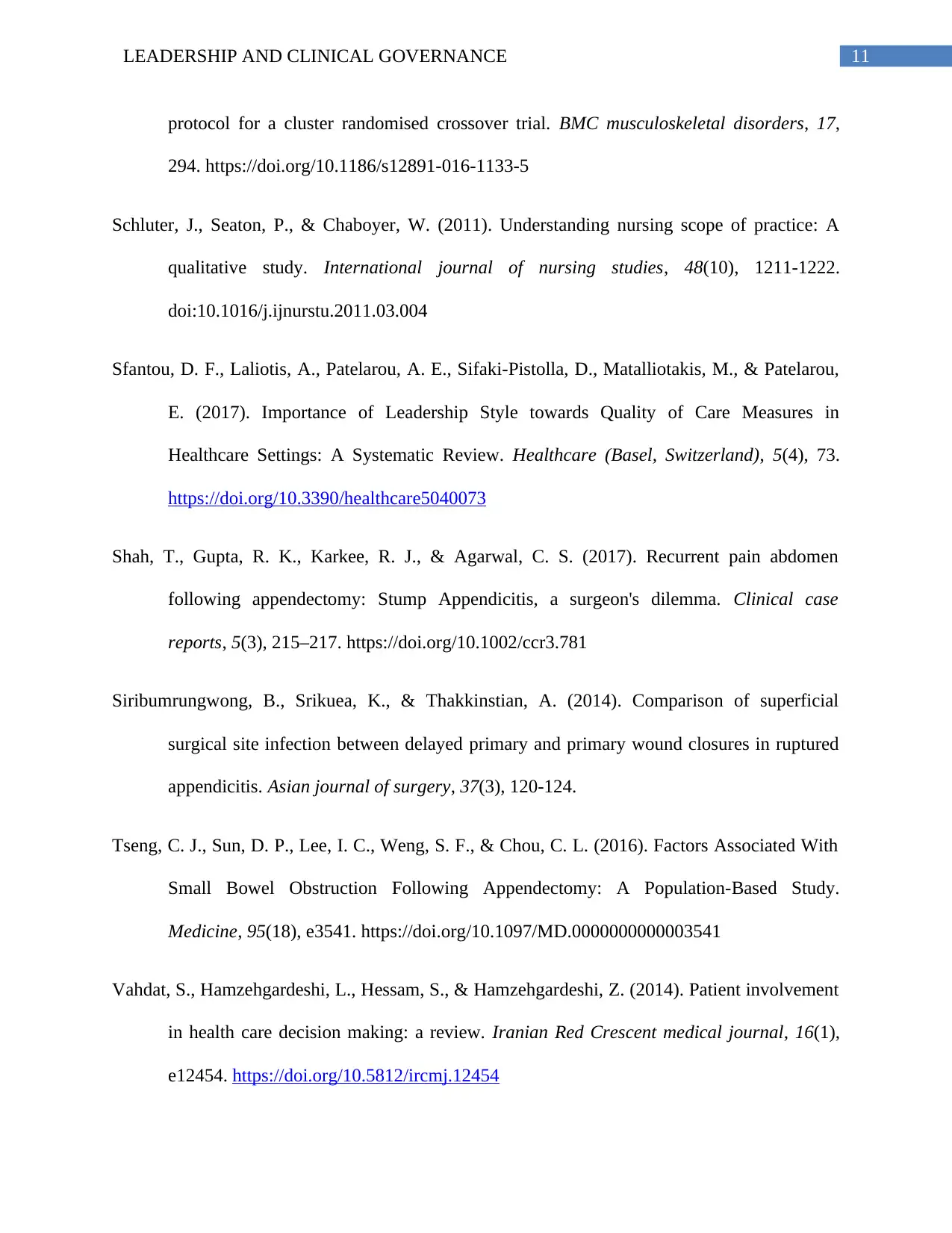
11LEADERSHIP AND CLINICAL GOVERNANCE
protocol for a cluster randomised crossover trial. BMC musculoskeletal disorders, 17,
294. https://doi.org/10.1186/s12891-016-1133-5
Schluter, J., Seaton, P., & Chaboyer, W. (2011). Understanding nursing scope of practice: A
qualitative study. International journal of nursing studies, 48(10), 1211-1222.
doi:10.1016/j.ijnurstu.2011.03.004
Sfantou, D. F., Laliotis, A., Patelarou, A. E., Sifaki-Pistolla, D., Matalliotakis, M., & Patelarou,
E. (2017). Importance of Leadership Style towards Quality of Care Measures in
Healthcare Settings: A Systematic Review. Healthcare (Basel, Switzerland), 5(4), 73.
https://doi.org/10.3390/healthcare5040073
Shah, T., Gupta, R. K., Karkee, R. J., & Agarwal, C. S. (2017). Recurrent pain abdomen
following appendectomy: Stump Appendicitis, a surgeon's dilemma. Clinical case
reports, 5(3), 215–217. https://doi.org/10.1002/ccr3.781
Siribumrungwong, B., Srikuea, K., & Thakkinstian, A. (2014). Comparison of superficial
surgical site infection between delayed primary and primary wound closures in ruptured
appendicitis. Asian journal of surgery, 37(3), 120-124.
Tseng, C. J., Sun, D. P., Lee, I. C., Weng, S. F., & Chou, C. L. (2016). Factors Associated With
Small Bowel Obstruction Following Appendectomy: A Population-Based Study.
Medicine, 95(18), e3541. https://doi.org/10.1097/MD.0000000000003541
Vahdat, S., Hamzehgardeshi, L., Hessam, S., & Hamzehgardeshi, Z. (2014). Patient involvement
in health care decision making: a review. Iranian Red Crescent medical journal, 16(1),
e12454. https://doi.org/10.5812/ircmj.12454
protocol for a cluster randomised crossover trial. BMC musculoskeletal disorders, 17,
294. https://doi.org/10.1186/s12891-016-1133-5
Schluter, J., Seaton, P., & Chaboyer, W. (2011). Understanding nursing scope of practice: A
qualitative study. International journal of nursing studies, 48(10), 1211-1222.
doi:10.1016/j.ijnurstu.2011.03.004
Sfantou, D. F., Laliotis, A., Patelarou, A. E., Sifaki-Pistolla, D., Matalliotakis, M., & Patelarou,
E. (2017). Importance of Leadership Style towards Quality of Care Measures in
Healthcare Settings: A Systematic Review. Healthcare (Basel, Switzerland), 5(4), 73.
https://doi.org/10.3390/healthcare5040073
Shah, T., Gupta, R. K., Karkee, R. J., & Agarwal, C. S. (2017). Recurrent pain abdomen
following appendectomy: Stump Appendicitis, a surgeon's dilemma. Clinical case
reports, 5(3), 215–217. https://doi.org/10.1002/ccr3.781
Siribumrungwong, B., Srikuea, K., & Thakkinstian, A. (2014). Comparison of superficial
surgical site infection between delayed primary and primary wound closures in ruptured
appendicitis. Asian journal of surgery, 37(3), 120-124.
Tseng, C. J., Sun, D. P., Lee, I. C., Weng, S. F., & Chou, C. L. (2016). Factors Associated With
Small Bowel Obstruction Following Appendectomy: A Population-Based Study.
Medicine, 95(18), e3541. https://doi.org/10.1097/MD.0000000000003541
Vahdat, S., Hamzehgardeshi, L., Hessam, S., & Hamzehgardeshi, Z. (2014). Patient involvement
in health care decision making: a review. Iranian Red Crescent medical journal, 16(1),
e12454. https://doi.org/10.5812/ircmj.12454
⊘ This is a preview!⊘
Do you want full access?
Subscribe today to unlock all pages.

Trusted by 1+ million students worldwide
1 out of 13
Related Documents
Your All-in-One AI-Powered Toolkit for Academic Success.
+13062052269
info@desklib.com
Available 24*7 on WhatsApp / Email
![[object Object]](/_next/static/media/star-bottom.7253800d.svg)
Unlock your academic potential
Copyright © 2020–2025 A2Z Services. All Rights Reserved. Developed and managed by ZUCOL.





